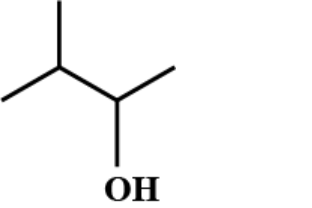
Identify the chiral molecule in the following pair.


Answer
560.1k+ views
Hint: An asymmetric carbon atom also known as chiral carbon, is a type of carbon atom that is attached to four different types of atoms or groups of atoms. Le Bel-van't Hoff rule states that the number of stereoisomers of an organic compound is ${2^n}$ , where n represents the number of asymmetric carbon atoms until and unless there is an internal plane of symmetry.
Complete step by step solution :
$3,4$-dimethylpentan-$2$-ol is chiral molecule or asymmetric molecule. The chiral Carbon atom is one in which four different atoms or groups are attached to it. If two or more groups are the same in it then the Carbon atom is not chiral.
So in this compound $ - OH$ attached to the carbon is a chiral molecule.
Additional information :
Chirality is derived from the Greek word kheir which stands for "hand". An object is known as chiral if the item and its duplicate photo are non-superimposable and similar to our right and left hand. Now you should be wondering what is ‘non-superimposable’. When the mirror photo of the item is placed over the authentic object and that they do not now overlap on each other ,then the item and its image are specified to be non-superimposable. Molecular chirality was revealed by Louis Pasteur back in $1848$, he successfully separated the two isomers of sodium ammonium tartrate and he observed that the two isomeric crystals were non-superimposable mirror images of each other and also they had the same physical properties, however differed in their ability to rotate plane polarized light. This property was called optical activity.
Note:
In non-polarized light, electric and magnetic fields are casually oriented in all planes. When the non-polarized light is made to pass through a polarizing filter then the oscillations get oriented in only one specific direction, and this is called plane polarized light.
Complete step by step solution :
$3,4$-dimethylpentan-$2$-ol is chiral molecule or asymmetric molecule. The chiral Carbon atom is one in which four different atoms or groups are attached to it. If two or more groups are the same in it then the Carbon atom is not chiral.
So in this compound $ - OH$ attached to the carbon is a chiral molecule.
Additional information :
Chirality is derived from the Greek word kheir which stands for "hand". An object is known as chiral if the item and its duplicate photo are non-superimposable and similar to our right and left hand. Now you should be wondering what is ‘non-superimposable’. When the mirror photo of the item is placed over the authentic object and that they do not now overlap on each other ,then the item and its image are specified to be non-superimposable. Molecular chirality was revealed by Louis Pasteur back in $1848$, he successfully separated the two isomers of sodium ammonium tartrate and he observed that the two isomeric crystals were non-superimposable mirror images of each other and also they had the same physical properties, however differed in their ability to rotate plane polarized light. This property was called optical activity.
Note:
In non-polarized light, electric and magnetic fields are casually oriented in all planes. When the non-polarized light is made to pass through a polarizing filter then the oscillations get oriented in only one specific direction, and this is called plane polarized light.
Recently Updated Pages
Master Class 11 Maths: Engaging Questions & Answers for Success

Master Class 11 Chemistry: Engaging Questions & Answers for Success

Master Class 11 Physics: Engaging Questions & Answers for Success

Master Class 11 Accountancy: Engaging Questions & Answers for Success

Master Class 11 Computer Science: Engaging Questions & Answers for Success

Why are manures considered better than fertilizers class 11 biology CBSE

Trending doubts
What is meant by exothermic and endothermic reactions class 11 chemistry CBSE

10 examples of friction in our daily life

One Metric ton is equal to kg A 10000 B 1000 C 100 class 11 physics CBSE

Difference Between Prokaryotic Cells and Eukaryotic Cells

What are Quantum numbers Explain the quantum number class 11 chemistry CBSE

1 Quintal is equal to a 110 kg b 10 kg c 100kg d 1000 class 11 physics CBSE




